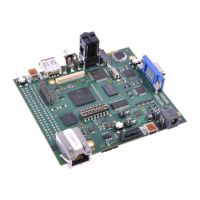
Do you have a question about the Texas Instruments TMS320C6748 and is the answer not in the manual?
| Brand | Texas Instruments |
|---|---|
| Model | TMS320C6748 |
| Category | Control Unit |
| Language | English |
Lists the key features of the TMS320C674x Fixed- and Floating-Point VLIW DSP.
Overview of C6748 hardware features, peripherals, on-chip memory, and package type.
Details terminal functions for RESET, NMI, and JTAG signals.
Details terminal functions for the External Memory Interface A.
Details terminal functions for the DDR2/mDDR Memory Controller.
Details terminal functions for SPI0 and SPI1 modules.
Details terminal functions for the Programmable Real-Time Unit.
Details boot mode selection terminal functions.
Details terminal functions for UART0, UART1, and UART2.
Details terminal functions for I2C0 and I2C1 modules.
Details terminal functions for McASP modules.
Details terminal functions for McBSP modules.
Details terminal functions for USB0 and USB1 modules.
Details terminal functions for the EMAC module.
Details terminal functions for MMC/SD card interfaces.
Details terminal functions for the LCD controller.
Details terminal functions for the SATA controller.
Details terminal functions for the UHPI interface.
Details terminal functions for the Universal Parallel Port.
Details terminal functions for the Video Port Interface.
Details terminal functions for supply and ground pins.
Describes the various boot modes supported by the internal DSP ROM bootloader.
Specifies the absolute maximum ratings for voltage and temperature.
Details handling precautions, including ESD voltage ratings.
Specifies recommended operating conditions for supply voltage and junction temperature.
Details electrical characteristics over recommended operating ranges.
Describes the required order for powering on the device's various supplies.
Explains the Power-On Reset behavior and its effects on device logic and pins.
Describes the EDMA3 Channel Controller and Transfer Controller registers.
Details the C674x DSP interrupt controller, prioritized interrupts, and registers.
